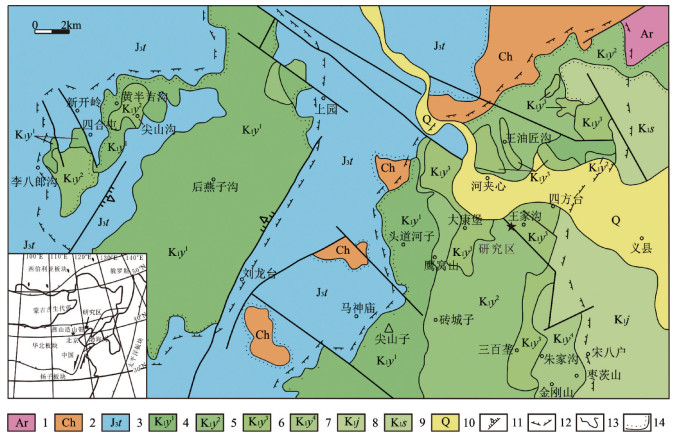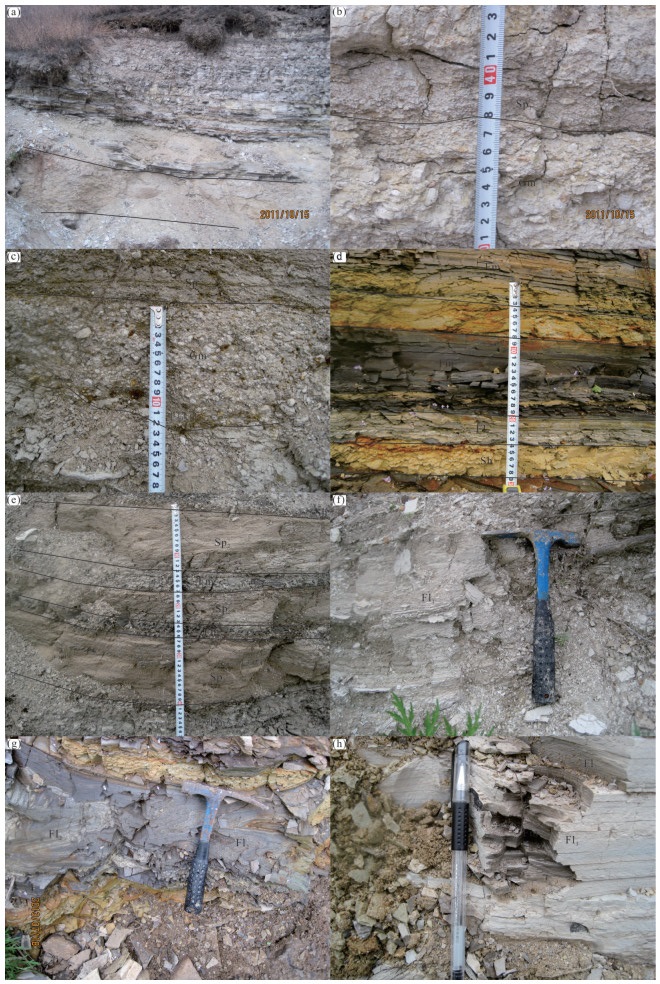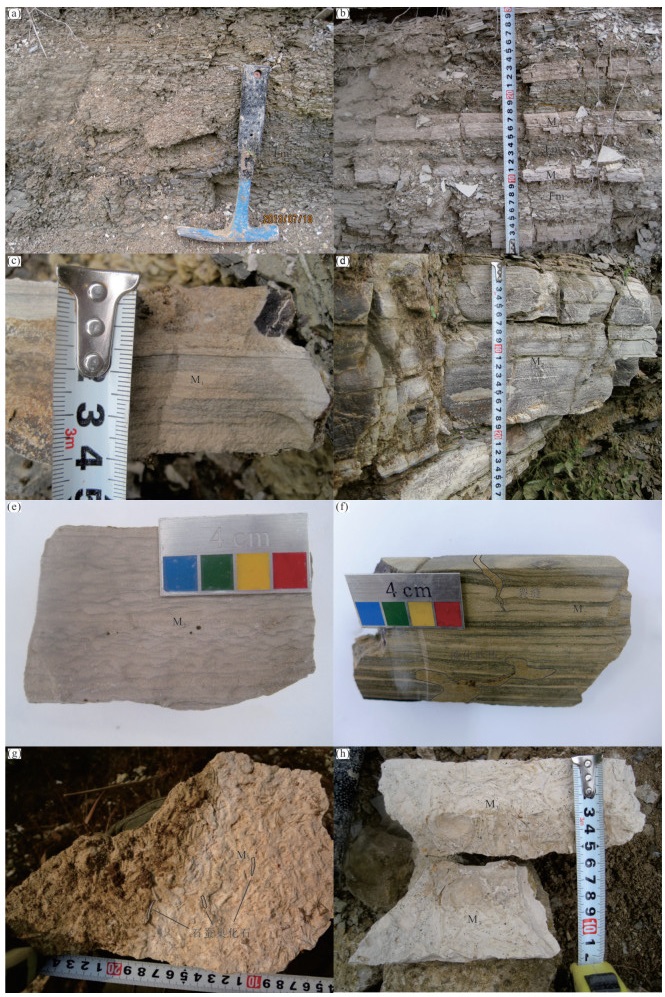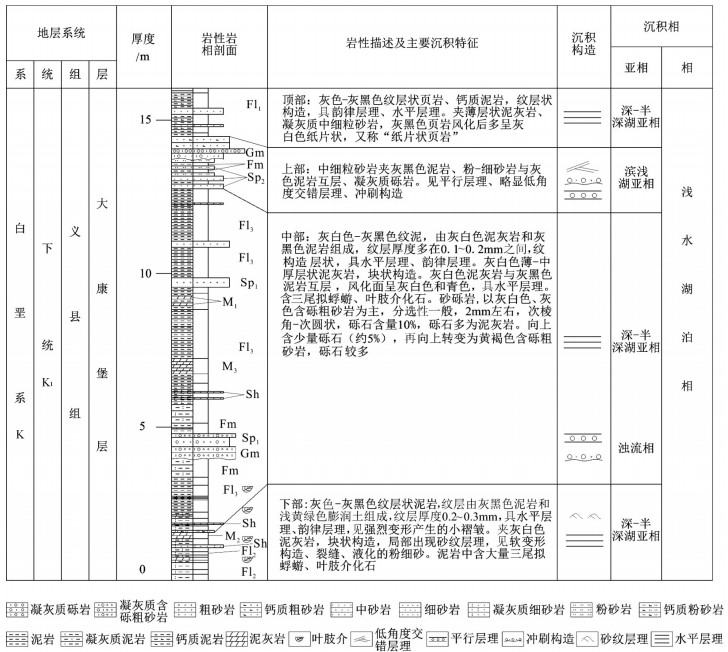Sedimentary characteristics and environmental evolution of Da-kangpu layer of Early Cretaceous Yixian Formation in western Liaoning
-
摘要:
辽西义县盆地下白垩统义县组大康堡沉积层分布范围广,为“热河生物群”的重要产出层位。通过对王家沟西山典型剖面的沉积学研究,识别出11种岩相类型,包括基质支撑砾岩相、凝灰质中-粗粒砂岩相、平行层理中-细砂岩相等,并将该时期的湖泊沉积划分为滨浅湖和深-半深湖环境。分析大康堡层垂向序列特征及纹泥特征,将该时期的湖泊演化划分为4个阶段:早期浅水湖泊沉积,见大量浅水生物化石;中期深-半深湖沉积,处于相对封闭-半封闭的状态,盐度增加;晚期湖泊水体变浅,水文动力条件增强,盐度降低;末期深-半深湖环境,纹泥指示陆源碎屑供给极少,降水较少。湖泊的演化过程受古气候控制明显。
Abstract:Widely distributed in Yixian Basin in western Liaoning, Dakangpu layer of the Yixian Formation belongs to Lower Creta-ceou and is an important horizon of "Jehol Biota". A typical section was measured in detail for sedimentology and 11 lithofacies types were recognized, such as matrix supported conglomerate facies, tuffaceous medium-coarse grained sandstone facies and medium-fine grained sandstone facies with parallel bedding. Dakangpu layer comprises mainly lacustrine sediments including shore shallow lake fa-cies and deep and semi-deep lake facies. Based on analyzing the changes of vertical sequence characteristics and varves characteristics of Dakangpu layer, the authors divided it into four depositional stages. At the initial stage, the lake was just formed with a large num-ber of shallow water fossils. After that it entered into the middle-range stage with deep and semi-deep water in the relatively closed and semi-closed state, during which the salinity increased. In the late depositional stage, the lake became shallow with higher hydrodynamic condition and low salinity. At the end of the deposition the lake had deep and semi-deep water, and the varves were devel-oped which indicated poor terrigenous clast and little precipitation. The evolution of the lake was controlled by paleoclimate obviously.
-
Keywords:
- Dakangpu layer /
- Jehol Biota /
- lithofacies /
- vertical sequence /
- varve
-
中亚造山带是世界上最大的古生代增生带和最大的显生宙大陆地壳生长带[1-7], 是一个持续俯冲增生造山带[8-10]。北山造山带作为中亚造山带的重要组成部分(图 1-a),是研究和支撑中亚造山带古生代构造格局的关键地区[12]。
![]() 图 1 北山造山带蛇绿岩时空分布(a)和中亚造山带构造简图(b)(据参考文献[11]修改)Figure 1. Temporal and spatial distribution of ophiolites in the Beishan orogenic belt(a) and structural sketch map of the Central Asian orogenic belt(b)
图 1 北山造山带蛇绿岩时空分布(a)和中亚造山带构造简图(b)(据参考文献[11]修改)Figure 1. Temporal and spatial distribution of ophiolites in the Beishan orogenic belt(a) and structural sketch map of the Central Asian orogenic belt(b)内蒙古北山地区位于中亚造山带南缘,西邻东天山,东接阿拉善,其大地构造位置较复杂[13-16]。经历了多阶段的俯冲拼贴过程,形成了从南向北依次出露的柳园-账房山、洗肠井-白云山-牛圈子-红柳河、小黄山-芨芨台子、红石山-百合山等多条蛇绿混杂岩带(图 1-b),前人对不同的蛇绿岩进行了研究,获得了丰富的资料[17-24]。近年的研究资料表明,北山造山带中部的洗肠井-白云山-牛圈子-红柳河蛇绿岩最早形成于寒武纪[13, 20, 25],奥陶纪向北强烈俯冲[10]。对于早泥盆世的构造属性,存在柳园蛇绿岩向北俯冲[26-28]、同碰撞或弧陆拼贴[29]、造山后伸展[30]等多种认识,泥盆纪岩浆岩成为研究古生代洋陆转化的重要载体之一。然而,前人的研究集中在花岗岩类,对火山岩的研究很少。李向民等[31]及Guo等[26]报道了在牛圈子地区的志留纪—泥盆纪三个井组火山岩,该火山岩地层的东西向延伸、区域对比亟需进一步研究。
鉴于此,本文以最新的1:5万填图资料及测试数据为基础,通过岩石学、岩石地球化学、锆石Lu-Hf同位素等特征的综合分析,对白云山南侧三个井组火山岩的时代归属进行重新厘定,研究其岩石成因及形成的大地构造环境,为探讨白云山洋盆的闭合时限提供重要的依据。
1. 区域地质
白云山东距额济纳旗约250 km,东临月牙山-洗肠井蛇绿构造混杂岩带,西部为牛圈子蛇绿岩带(图 1)。白云山蛇绿岩带呈北西西向带状展布,东西长约26 km,南北宽2~4.5 km。下部主要出露橄榄岩、辉橄岩、二辉橄榄岩等超基性杂岩,普遍蛇纹石化,构造混杂岩带强糜棱岩化,辉长岩和斜长花岗岩呈岩株状侵出地表;上部为红褐色-紫红色含放射虫硅质岩,构造作用强烈,多呈岩块分布于蛇绿构造混杂岩带中,表现出远洋沉积的特征并被后期辉绿岩脉侵入。蛇绿构造混杂岩带北部为晚奥陶世白云山组弧前盆地沉积建造及中志留世石英闪长岩,被认为是哈萨克斯坦板块与塔里木板块之间大洋俯冲的产物[13]。混杂岩带南部出露二叠纪、泥盆纪侵入体,地层主要为被动陆缘沉积的晚奥陶世锡林柯博组,主要岩性为灰绿色变质长石岩屑砂岩、灰绿色变质长石石英砂岩、灰褐色白云岩等,被敦煌地块中新元古界碳酸盐岩沉积盖层逆冲掩覆。研究区三个井组是从前人认为的横峦山群中新识别而来的,与北侧的锡林柯博组呈断层接触,岩石组合主要为一套凝灰质长石岩屑砂岩、凝灰质粉砂岩、硅质粘土岩夹基性-中基性火山岩。火山岩主要由玄武岩、玄武安山岩、流纹质凝灰岩等组成,玄武岩以层状构造为主,部分发育枕状构造及气孔杏仁状构造(图 2-a)。
![]() 图 2 月牙山幅地质简图(a)和三个井组PM06实测剖面(b)①a图:1—中、新元古界;2—寒武纪—奥陶纪西双鹰山组;3—晚奥陶世锡林克博组;4—晚奥陶世白云山组;5—早泥盆世三个井组二段;6—晚泥盆世墩墩山组;7—早白垩世赤金堡组;8—新近系;9—第四系;10—白云岩透镜体;11—蛇绿岩带;12—超基性岩块;13—花岗闪长岩;14—石英闪长岩脉;15—闪长岩脉;16—断层;17—PM06剖面位置;b图:1—安山质晶屑凝灰岩;2—长石岩屑砂岩;3—凝灰质长石岩屑砂岩;4—杏仁状安山岩;5—玄武岩;6—流纹斑岩;7—闪长岩;8—硅质白云岩;9—结晶灰岩;10—安山岩;11—断层破碎带;12—不整合界线;13—产状;14—采样位置Figure 2. Geological map of Yueyashan Sheet(a)and measured profile PM06 of Sangejing Formation(b)
图 2 月牙山幅地质简图(a)和三个井组PM06实测剖面(b)①a图:1—中、新元古界;2—寒武纪—奥陶纪西双鹰山组;3—晚奥陶世锡林克博组;4—晚奥陶世白云山组;5—早泥盆世三个井组二段;6—晚泥盆世墩墩山组;7—早白垩世赤金堡组;8—新近系;9—第四系;10—白云岩透镜体;11—蛇绿岩带;12—超基性岩块;13—花岗闪长岩;14—石英闪长岩脉;15—闪长岩脉;16—断层;17—PM06剖面位置;b图:1—安山质晶屑凝灰岩;2—长石岩屑砂岩;3—凝灰质长石岩屑砂岩;4—杏仁状安山岩;5—玄武岩;6—流纹斑岩;7—闪长岩;8—硅质白云岩;9—结晶灰岩;10—安山岩;11—断层破碎带;12—不整合界线;13—产状;14—采样位置Figure 2. Geological map of Yueyashan Sheet(a)and measured profile PM06 of Sangejing Formation(b)2. 岩石学特征
枕状玄武岩:中等风化程度,风化面呈灰色-灰绿色,新鲜面呈深灰色-灰色,局部枕状构造明显,表面常见小气孔。主要矿物组成为斜长石+辉石(75%),暗色矿物(25%),岩石由斑晶、基质组成。斑晶主要由矿物假象组成,粒径约1 mm,零星分布,后期被帘石交代呈假象产出,含量约为2%。基质由斜长石、暗色矿物组成,粒径小于0.2 m。斜长石呈板条状,长轴多显定向排列,略显残余间粒结构,后期具帘石化、粘土化、褐铁矿化、碳酸盐化、次闪石化;暗色矿物后期多具帘石化、褐铁矿化、次闪石化呈假象产出。岩内可见被硅质、褐铁矿、少量碳酸盐矿物充填的微裂纹。
气孔-杏仁状玄武岩:风化作用较强,风化面和新鲜面都为深灰色,岩内未见斑晶。岩石由斜长石、辉石和暗色矿物组成,斜长石含量约为65%,辉石含量约20%,暗色矿物约为15%。斜长石呈半自形板状、板条状,粒径为0.1~1 mm,长轴定向排列,显交织结构,后期具粘土化、绢云母化、碳酸盐化、褐铁矿化。暗色矿物后期具帘石化、褐铁矿化、碳酸盐化、绿泥石化,呈假象产出,杂乱分布于斜长石间。岩内多见被碳酸盐、硅质、帘石充填的杏仁体,呈云朵状、不规则状,大小为0.5~10 mm,长轴多显定向排列,岩内另见被碳酸盐矿物充填的裂隙。杏仁体占岩石体积的10%~15%。
3. 实验方法
用于岩石地球化学研究的玄武岩样品采自白云山一带锡林柯博组南部三个井组剖面(PM06)(图 2-b),样品采集过程中避开脉体发育地段。样品分别进行主量和微量元素测试。样品磨碎至200目后,在中国地质调查局天津地质调查中心实验室进行主量和微量元素分析测试。主量元素使用X-射线荧光光谱仪(XRF-1500)法测试,误差优于2%~3%。微量及稀土元素利用酸溶法制备样品,使用ICP-MS(ElementⅡ)测试,分析误差优于10%。化学分析测试流程见参考文献[32-33]。
本次选取(PM06)实测剖面中的气孔状玄武岩样品(4206-1),采样位置为北纬98°29′44″、东经41°32′36″。锆石分选由河北省廊坊诚信地质服务有限公司完成,首先进行粉碎分选,分选出的锆石在双目镜下挑选,选择透明度较高、晶形较完好且内部无裂隙具有代表性的锆石进行制靶,锆石阴极发光图像制备、制靶工作由北京锆年领航科技有限公司完成。通过反射光、透射光及阴极发光图像综合分析,选择晶形好、环带清晰的锆石样品进行测试。锆石LA-ICP-MS测试在天津地质调查中心实验室完成,利用激光剥蚀等离子体质谱仪(LA-ICP-MS)进行锆石U-Pb同位素测试。
激光剥蚀系统为New Wave UP213,ICP-MS为布鲁克M90。激光剥蚀过程中采用氦气作载气、氩气为补偿气以调节灵敏度,二者在进入ICP之前通过一个Y型接头混合。每个时间分辨分析数据包括20~30 s的空白信号和50 s的样品信号。对分析数据的离线处理(包括对样品和空白信号的选择、仪器灵敏度漂移校正、元素含量及U-Th-Pb同位素比值和年龄计算)采用软件ICPMSDataCal[34]完成。锆石样品的U-Pb谐和图绘制和年龄加权平均计算均采用Isoplot/Ex_ver3[35]完成。本次测试剥蚀直径根据实际情况选择25 μm。
锆石Hf同位素组成的分析是在阴极发光(CL)图像分析和锆石U-Pb定年的基础上进行的,分析前将锆石再次清洗干净并晾干。测试在天津地质调查中心实验室ThermoFinnigan Neptune型多接收电感耦合等离子质谱仪MC-ICP-MS上进行,各颗粒分析点的位置与锆石U-Pb分析的位置相同,激光频率为8 Hz,束斑直径为44 μm,信号采集时间26 s,详细分析流程见参考文献[36]。在计算初始176 Hf/177Hf值时,Lu的衰变常数采用1.867×10-11a-1[37],εHf值的计算采用[38]推荐的球粒陨石Hf同位素值,176 Lu/177Hf = 0.0336,176Hf/177Hf = 0.282785。在Hf单阶段模式年龄计算中,亏损地幔176Hf/177Hf现在值采用0.28325,176Lu/177Hf采用0.0384[39],两阶段模式年龄计算时采用平均地壳的176Lu/177Hf = 0.015[40]。
4. 分析结果
4.1 主量元素
白云山地区三个井组玄武岩的主量元素分析结果见表 1,SiO2含量为41.48%~48.36%,平均为46.03%,Na2O为2.93%~3.75%,平均为3.27%,K2O质量分数变化较大,为0.08%~2.06%,可能反映岩石后期变质较强。TiO2含量为1.76%~2.66%,平均为2.10%,Al2O3含量较高为14.55%~16.55%,平均为15.43%,FeO含量较高,为3.58%~6.13%,平均为5.22%。Fe2O3含量为2.74%~7.06%,平均为4.60%。Mg#值为43.19~67.93,平均为56.71,明显低于原生岩浆范围(Mg#=68~75)[41],同样低于典型的MORB的Mg#[42],表明岩浆经历了结晶分异作用。
表 1 三个井组玄武岩主量、微量和稀土元素分析结果Table 1. Geochemical data of major, trace elements and REE for Sangejing Formation basalt样号 P6YQ18-1 P6YQ25-1 P6YQ25-2 YQ4206-1 SiO2 41.48 48.36 46.87 47.41 Al2O3 16.55 14.92 14.55 15.68 Fe2O3 2.74 4.24 7.06 4.37 FeO 5.34 5.82 3.58 6.13 CaO 11.50 11.82 11.89 9.28 MgO 2.83 6.08 6.37 6.84 K2O 2.06 0.45 0.20 0.08 Na2O 3.75 2.93 3.12 3.28 TiO2 2.66 1.76 1.98 1.99 P2O5 0.47 0.21 0.22 0.24 MnO 0.13 0.16 0.19 0.15 灼失量 9.91 2.61 2.99 3.87 总计 99.42 99.36 99.02 99.32 Mg# 43.19 56.96 58.77 67.93 Hf 5.73 3.55 4.06 4.21 Zr 213 124 137 142 Cr 154 211 239 236 Ni 57.00 73.60 93.70 73.80 Ga 22.50 19.20 20.40 19.10 Rb 29.40 6.22 5.20 1.84 Sr 230 476 478 371 Y 282 267 32.2 392 Nb 18.50 8.05 9.61 9.39 Cs 2.29 0.13 0.24 0.15 Ba 173 554 237 94.4 Ta 1.35 0.63 0.74 0.68 Pb 1.94 1.83 2.12 2.18 Th 1.93 1.20 1.14 1.05 U 0.94 0.31 0.31 0.33 La 18.30 9.90 10.40 14.60 Ce 41.80 23.90 24.50 20.80 Pr 6.07 3.63 3.70 4.25 Nd 27.40 17.60 18.20 18.60 Sm 6.90 4.85 4.97 5.15 Eu 2.22 1.75 1.74 1.65 Gd 7.63 5.73 4.97 5.49 Tb 1.30 1.00 1.02 0.92 Dy 7.70 6.22 6.37 5.99 Ho 1.50 1.23 1.28 1.26 Er 3.88 3.31 3.39 3.46 Tm 0.56 0.48 0.51 0.52 Yb 3.61 3.30 3.35 3.39 Lu 0.54 0.50 0.51 0.50 ∑LREE 102.69 61.63 63.51 65.05 ∑HREE 26.72 21.77 21.4 21.53 LREE/HREE 3.84 2.83 2.97 3.02 (La/Yb)N 3.42 2.02 2.09 2.9 δEu 0.94 1.02 1.07 0.95 Nb/Y 0.50 0.26 0.30 0.54 ΔNb 0.79 0.86 0.01 0.97 注:Mg#=100×Mg/(Mg+Fe),△Nb=1.74+lg(Nb/Y)-1.92×lg(Zr/Y);主量元素含量单位为%,微量和稀土元素含量单位为10-6 本次采集的4个三个井组火山岩样品,在火山岩TAS图解(图 4-a)上有3件落入玄武岩区域。Pearce提出的Nb/Y-Zr/TiO2×10-4图解被认为是划分蚀变、变质火山岩系列的有效图解[44]。由图 4-b可以看出,全部样品落入亚碱性玄武岩区域。进一步通过AFM图解(图 5)可知,亚碱性玄武岩基本为拉斑玄武岩系列。
![]() 图 4 火山岩TAS图解(a)[43]和玄武岩Nb/Y-TiO2×10-4图解(b)Pc—苦橄玄武岩;B—玄武岩;O1—玄武安山岩;O2—安山岩;O3—英安岩;R—流纹岩;S1—粗面玄武岩;S2—玄武质粗面安山岩;S3—粗面安山岩;T—粗面岩、粗面英安岩;F—副长石岩;U1—碱玄岩、碧玄岩;U2—响岩质碱玄岩;U3—碱玄质响岩;Ph—响岩;Ir—Irvine分界线,上方为碱性,下方为亚碱性Figure 4. TAS diagram for volcanic rock(a)and Nb/Y-TiO2×10-4 diagram for basalts(b)
图 4 火山岩TAS图解(a)[43]和玄武岩Nb/Y-TiO2×10-4图解(b)Pc—苦橄玄武岩;B—玄武岩;O1—玄武安山岩;O2—安山岩;O3—英安岩;R—流纹岩;S1—粗面玄武岩;S2—玄武质粗面安山岩;S3—粗面安山岩;T—粗面岩、粗面英安岩;F—副长石岩;U1—碱玄岩、碧玄岩;U2—响岩质碱玄岩;U3—碱玄质响岩;Ph—响岩;Ir—Irvine分界线,上方为碱性,下方为亚碱性Figure 4. TAS diagram for volcanic rock(a)and Nb/Y-TiO2×10-4 diagram for basalts(b)![]() 图 5 AFM图解[45]Figure 5. AFM diagram
图 5 AFM图解[45]Figure 5. AFM diagram4.2 稀土和微量元素
白云山地区蛇绿混杂岩带南侧三个井组玄武岩稀土元素分析结果见表 1。稀土元素总量(∑REE)为83.40×10-6~129.41×10-6, 平均为96.08×10-6,其中轻稀土元素(∑LREE)为67.36×10-6~110.32×10-6,平均为79.18×10-6,重稀土元素(∑HREE)为16.04×10-6~19.09×10-6,平均为16.90×10-6,轻、重稀土元素分馏明显,LREE/HREE值为4.17~5.78,平均为4.64,轻稀土元素较重稀土元素明显富集。(La/Yb)N值为2.15~3.64,稀土元素球粒陨石标准化配分曲线整体呈现轻稀土元素富集的右倾型(图 6-a),显示岛弧玄武岩的地球化学特征。δEu值为0.94~1.07,没有明显的Eu异常,表明没有发生斜长石结晶分异作用。
微量元素分析结果见表 1。Nb/Y值为0.26~0.54,主体小于1,是源区低压熔融的结果[33]。微量元素原始地幔标准化蛛网图(图 6-b)显示,大离子亲石元素具有强烈的分异特征,Rb、Ba、Th、U、K等大离子亲石元素变化较大,可能与海相玄武岩形成时遭受海水热液蚀变及后期绿泥石、透闪石蚀变有关[48]。高场强元素整体含量变化不大,Nb等高场强元素呈亏损的特征。
4.3 锆石U-Pb年龄
本次分析获得32个测点的数据(表 2),由锆石阴极发光图像(图 7)可知,锆石颗粒多为暗黑,大部分锆石具有清晰的岩浆振荡环带。Th/U值介于0.06~1.62之间,绝大多数大于0.4,说明绝大多数锆石为岩浆成因[49-51]。玄武岩锆石通常为自形-半自形的板柱状或不具有韵律生长环带的浑圆状、不规则状。由CL图像可知,本次挑选的32颗锆石不完全属于玄武岩锆石,如15、16、19、25、30号等均属于花岗岩类的锆石,所以最终挑选出9颗玄武岩锆石进行研究(图 8-a)。
表 2 三个井组玄武岩样品(4206-1)LA-ICP-MS锆石U-Th-Pb数据Table 2. LA-ICP-MS zircons U-Th-Pb data of Sangejing Formation basalt(4206-1)测点号 Th/10-6 U/10-6 Pb/10-6 Th/U 同位素比值 年龄/Ma 207Pb/206Pb 1σ 207Pb/235U 1σ 206Pb/238U 1σ 207Pb/206Pb 1σ 207Pb/235U 1σ 206Pb/238U 1σ 4206.1.01 86 105 7 0.82 0.057 0.002 0.494 0.014 0.057 0.002 484 58 408 11 394 4 4206.1.02 100 195 13 0.52 0.057 0.002 0.501 0.017 0.057 0.002 471 80 413 14 402 5 4206.1.03 105 998 34 0.11 0.053 0.001 0.266 0.006 0.053 0.001 329 30 240 5 231 4 4206.1.04 91 125 9 0.73 0.055 0.002 0.486 0.014 0.055 0.002 430 62 402 12 397 4 4206.1.05 19 62 4 0.31 0.053 0.003 0.469 0.026 0.053 0.003 326 120 390 21 401 5 4206.1.06 57 115 7 0.50 0.054 0.005 0.416 0.041 0.054 0.005 383 221 353 35 349 4 4206.1.07 147 116 6 1.26 0.052 0.002 0.304 0.012 0.052 0.002 270 86 270 10 270 3 4206.1.08 88 300 19 0.29 0.056 0.001 0.492 0.010 0.056 0.001 465 43 406 8 396 4 4206.1.09 140 182 13 0.77 0.055 0.002 0.487 0.018 0.055 0.002 397 84 403 15 404 4 4206.1.10 66 82 4 0.80 0.052 0.002 0.321 0.015 0.052 0.002 263 107 282 13 285 3 4206.1.11 90 172 12 0.52 0.055 0.001 0.496 0.012 0.055 0.001 424 51 409 10 406 4 4206.1.12 418 555 40 0.75 0.056 0.001 0.504 0.007 0.056 0.001 457 28 414 6 406 4 4206.1.13 51 246 115 0.21 0.163 0.002 0.109 0.156 0.163 0.002 2486 19 2445 38 2396 30 4206.1.14 383 294 23 1.30 0.057 0.001 0.495 0.009 0.057 0.001 485 37 409 7 395 4 4206.1.15 65 110 7 0.59 0.056 0.003 0.490 0.030 0.056 0.003 461 135 405 25 395 4 4206.1.16 133 162 10 0.82 0.054 0.001 0.398 0.010 0.054 0.001 387 52 340 8 333 4 4206.1.17 135 282 18 0.48 0.055 0.002 0.468 0.014 0.055 0.002 396 66 390 11 388 4 4206.1.18 538 332 206 1.62 0.166 0.002 0.910 0.144 0.166 0.002 2521 19 2515 33 2509 25 4206.1.19 223 587 38 0.38 0.056 0.001 0.493 0.009 0.056 0.001 449 39 407 8 399 4 4206.1.20 40 56 4 0.72 0.057 0.002 0.496 0.022 0.057 0.002 499 94 409 18 393 4 4206.1.21 44 58 4 0.76 0.056 0.003 0.483 0.027 0.056 0.003 460 119 400 22 390 4 4206.1.22 261 337 13 0.77 0.052 0.001 0.259 0.006 0.052 0.001 286 43 234 5 229 3 4206.1.23 122 226 75 0.54 0.110 0.001 4.704 0.062 0.110 0.001 1791 21 1768 23 1748 17 4206.1.24 257 710 46 0.36 0.056 0.001 0.486 0.008 0.056 0.001 431 34 402 7 397 4 4206.1.25 136 175 12 0.78 0.058 0.001 0.491 0.011 0.058 0.001 519 45 406 9 386 4 4206.1.26 176 623 38 0.28 0.056 0.001 0.488 0.007 0.056 0.001 464 27 403 6 393 4 4206.1.27 198 558 36 0.35 0.056 0.001 0.496 0.008 0.056 0.001 447 30 409 6 402 4 4206.1.28 87 215 14 0.41 0.058 0.001 0.502 0.011 0.058 0.001 518 41 413 9 395 4 4206.1.29 152 424 27 0.36 0.056 0.001 0.496 0.007 0.056 0.001 468 28 409 6 399 4 4206.1.30 249 399 31 0.62 0.056 0.001 0.496 0.012 0.056 0.001 448 44 409 9 402 4 4206.1.31 17 280 95 0.06 0.116 0.001 5.523 0.073 0.116 0.001 1900 21 1904 25 1908 19 4206.1.32 661 1208 137 0.55 0.068 0.001 1.029 0.016 0.068 0.001 882 24 718 11 667 8 4206-1样品中9颗玄武岩锆石的测试结果显示,9颗锆石的数据点都位于谐和线上或附近(图 8-b),其206Pb/238U年龄值明显分为2组,第一组7颗锆石的206Pb/238U年龄介于393~406 Ma之间,年龄加权平均值为396.6±3.3 Ma(MSWD=1.9)(图 8-b);第二组为270 Ma、285 Ma两个较年轻的锆石年龄。通过分析认为,数据较多且较集中的第一组年龄是玄武岩的岩浆结晶年龄,即早泥盆世,而第二组2个年轻的年龄可能是后期混入的岩浆碎屑锆石。
4.4 锆石Lu-Hf同位素
本次对白云山一带三个井组玄武岩U-Pb年龄测定的样品进行了锆石Lu-Hf同位素测试,测点尽量与U-Pb年龄测定位置相同或靠近,结果见表 3。通过5个点的测定,εHf(t)=+4.67~+8.02,176Hf/177Hf=0.282662~0.282762;一阶段锆石Hf模式年龄tDM1=692~826 Ma。
表 3 三个井组玄武岩锆石Lu-Hf同位素数据Table 3. Lu-Hf isotope data of Sangejing Formation basalt测点号 t/Ma 176Yb/177Hf 176Lu/177Hf 176Hf/177Hf 176Hf/177Hfi 2σ εHf(0) εHf(t) tDM1/Ma tDM2/Ma fLu/Hf 4206.01.11 406 0.020250 0.000876 0.282678 0.282672 0.000029 -3.31 5.40 811 1052 -0.97363 4206.01.14 395 0.017497 0.000782 0.282692 0.282686 0.000029 -2.82 5.67 789 1026 -0.97646 4206.01.20 393 0.013875 0.000589 0.282664 0.282660 0.000027 -3.82 4.68 825 1087 -0.98225 4206.01.21 390 0.019975 0.000787 0.282762 0.282756 0.000069 -0.36 8.02 692 873 -0.97630 4206.01.28 395 0.012072 0.000507 0.282662 0.282658 0.000022 -3.90 4.67 826 1090 -0.98474 5. 讨论
5.1 火山岩地层形成时代及归属讨论
白云山地区“横峦山群或咸水湖组”的时代及地层归属一直备受争议②[52]。甘肃省第二区测队1972年开展石板井幅1:20万区测时,依据岩石组合特征,将该套火山岩划分为横峦山群;甘肃地质力学测量队1977年、1979年开展五道明幅、黑鹰山幅、六驼山幅1:20万区测时,又将该套火山岩划分为咸水湖群。李文国等[52]通过对比研究,认为北山地区该套火山岩地层仍属于咸水湖组,同样缺乏确凿证据。尽管本次研究的该套火山岩与前人划分的横峦山群或咸水湖组火山岩的岩性组合、颜色具有相似性,然而,本次获得玄武岩锆石206Pb/238U年龄加权平均值为396.6±3.3 Ma(MSWD=1.9),属早泥盆世,并非前人划分的中奥陶世。前人在甘肃北山红柳园地区测得三个井组火山岩形成于420±15 Ma,所以将红柳园地区蛇绿岩带南侧的三个井组时代更新为晚志留世[31, 53],红柳园地区三个井组岩石组合为杏仁玄武岩、凝灰质砂岩夹粉砂岩及灰岩透镜体砾岩;白云山地区三个井组一段为灰黑色玄武岩、灰黑色细砂岩夹薄层灰白色-浅灰色灰岩、硅质岩等,二段为灰绿色长石岩屑细砂岩、中细砂岩夹复成分砾岩、灰岩透镜体、灰绿色枕状玄武岩、晶屑凝灰岩等。从年代学及岩石组合看,二者极相似,笔者认为,白云山一带所谓的横峦山群或咸水湖组应划分为下泥盆统三个井组。
5.2 构造环境
北山造山带是天山-兴蒙造山带的关键枢纽地带[20],该地区经历了南华纪前大陆地壳基底演化、超大陆裂解和洋壳演化、碰撞期后板内伸展-陆内叠覆造山4个演化阶段[54]。研究区蛇绿岩岩块仅出露于晚奥陶世锡林柯博组中,在三个井组未发现蛇绿岩岩块,因此蛇绿岩就位于早泥盆世之前,三个井组可能为洋盆闭合后伸展背景下形成。而且,本文厘定的三个井组拉斑玄武岩与区域大面积出露的泥盆纪S型、A型花岗岩[29]在空间上紧密伴生,在区域上并未发现同时代的安山岩等中性岩浆活动,即SiO2含量存在明显的Daly间断。由此可见,北山造山带中部早泥盆世为伸展构造背景。
地球化学特征是判别火山岩形成环境的重要标志之一。对于发生蚀变或弱变质作用的火山岩,使用在蚀变和变质作用过程中受影响最小、稳定性较好的Zr、Th、Nb、Ta、Y等高场强元素进行构造环境判别比较有效。玄武岩构造环境Nb/Zr-Th/Zr判别图解(图 9)显示,玄武岩具有裂谷背景的地球化学特征,TiO2/Al2O3-Zr/Al2O3及Zr/TiO2-Ce/P2O5构造环境判别图解(图 10)显示,玄武岩投点位于后碰撞弧范围,判别图解显示的弧岩浆岩地球化学特征与稀土元素配分曲线显示的岛弧玄武岩配分曲线特征吻合。综上所述,三个井组玄武岩形成于伸展的构造背景,源区具有岛弧玄武岩的部分特征。
![]() 图 9 玄武岩大地构造环境Nb/Zr-Th/Zr双对数判别图[55]Ⅰ—大洋板块发散边缘N-MORB区; Ⅱ—板块汇聚边缘(Ⅱ1—大洋岛弧玄武岩区; Ⅱ2—陆缘岛弧及陆缘火山弧玄武岩区); Ⅲ—大洋板内(洋岛、海山玄武岩区、T-MORB、E-MORB区); Ⅳ—大陆板内(Ⅳ1—陆内裂谷及陆缘裂谷拉斑玄武岩区; Ⅳ2—大陆拉张带(或初始裂谷)玄武岩区; Ⅳ3—陆-陆碰撞带玄武岩区); Ⅴ—地幔热柱玄武岩区Figure 9. Th /Zr and Nb /Zr double logarithmic plot for identification of tectonic settings for basalts
图 9 玄武岩大地构造环境Nb/Zr-Th/Zr双对数判别图[55]Ⅰ—大洋板块发散边缘N-MORB区; Ⅱ—板块汇聚边缘(Ⅱ1—大洋岛弧玄武岩区; Ⅱ2—陆缘岛弧及陆缘火山弧玄武岩区); Ⅲ—大洋板内(洋岛、海山玄武岩区、T-MORB、E-MORB区); Ⅳ—大陆板内(Ⅳ1—陆内裂谷及陆缘裂谷拉斑玄武岩区; Ⅳ2—大陆拉张带(或初始裂谷)玄武岩区; Ⅳ3—陆-陆碰撞带玄武岩区); Ⅴ—地幔热柱玄武岩区Figure 9. Th /Zr and Nb /Zr double logarithmic plot for identification of tectonic settings for basalts![]() 图 10 三个井组玄武岩TiO2/Al2O3-Zr/Al2O3图解(a)和Zr/TiO2-Ce/P2O5图解(b)[56]WIP—板内;CAP—陆弧;PAP—后碰撞弧;IOP—初始洋弧;LOP—晚期洋弧Figure 10. TiO2/Al2O3-Zr/Al2O3 (a)and Zr/TiO2-Ce/P2O5 (b)diagrams of Sangejing Formation basalts
图 10 三个井组玄武岩TiO2/Al2O3-Zr/Al2O3图解(a)和Zr/TiO2-Ce/P2O5图解(b)[56]WIP—板内;CAP—陆弧;PAP—后碰撞弧;IOP—初始洋弧;LOP—晚期洋弧Figure 10. TiO2/Al2O3-Zr/Al2O3 (a)and Zr/TiO2-Ce/P2O5 (b)diagrams of Sangejing Formation basalts5.3 岩石成因
锆石的Lu-Hf同位素体系有很高的封闭温度,且相对于U-Pb同位素体系更不易被后期流体、热事件改造[57],使得锆石可以记录岩浆源区的信息。因此,采用Hf同位素研究岩浆的来源。
三个井组玄武岩εHf(t)为较高的正值(+4.67~+8.02),为地幔物质部分熔融的产物。在t-176Hf/177Hf图解(图 11-a)上,数据点落入球粒陨石Hf同位素演化线和亏损地幔之间区域,相对集中,且tDM1=692~826 Ma,表明三个井组玄武岩源区主要为新元古代亏损地幔。其微量元素Ni(154.00×10-6~522.00×10-6)和Cr(57.00×10-6~453.00×10-6)含量主体低于原始岩浆的参考数值[58](Ni≈250.00×10-6、Cr≈300.00×10-6),仅有1个样品Ni、Cr含量高于该参考值,表明该玄武岩浆早期演化过程中可能发生过橄榄石、辉石的结晶分离作用,这与该区玄武岩较低的Mg#值吻合。研究表明,Dy/Yb值代表来源于不同矿物相源区、不同部分熔融程度的玄武岩浆[59]。一般认为,当Dy/Yb>2.50时,部分熔融发生在含石榴子石地幔源区,当Dy/Yb<1.50时,则为尖晶石地幔源区[60]。三个井组玄武岩的Dy/Yb值为1.77~2.13,在La/Yb-Dy/Yb图解(图 11-b)中,处于石榴子石二辉橄榄岩熔融趋势线以下,尖晶石二辉橄榄岩熔融趋势线以上,部分熔融程度接近20%。
6. 结论
(1) LA-ICP-MS锆石U-Pb定年结果表明,北山地区白云山蛇绿岩带南部玄武岩锆石的206Pb/238U年龄加权平均值为396.6±3.3 Ma,应为早泥盆世三个井组火山岩。
(2) 三个井组玄武岩岩浆来自新元古代亏损地幔的局部熔融,可能是亏损尖晶石相地幔橄榄岩向石榴子石相地幔橄榄岩过渡相较高程度部分熔融的产物,且在上升过程中可能受到一定程度的地壳物质混染。
(3) 三个井组玄武岩主要为拉斑玄武岩系列,与区域上同期的S型、A型花岗岩构成双峰式岩浆岩,结合地球化学研究认为其处于造山后伸展构造环境。
-
图 1 辽西地区义县盆地和金-羊盆地义县组分布及地质简图(据参考文献[12]修改)
1—太古宙变质岩;2—长城系变质岩;3—土城子组;4—义县组一段;5—义县组二段;6—义县组三段;7—义县组四段;8—九佛堂组;9—沙海组;10—第四系;11—断裂;12—火山构造洼地;13—地质界线;14—平行/角度不整合
Figure 1. The distribution and geological sketch map of Yixian Formation in Yixian and Jin-Yang basins, western Liaoning
表 1 义县盆地义县组大康堡层岩相划分
Table 1 Lithofacies classification of the Dakangbao layer of Yixian Formation in Yixian basin
岩相类型 代码 沉积特征 成因解释 基质支撑砾岩相 Gm 成分混杂,凝灰质、膨润土质胶结,砾石多为泥灰岩,少量玄武岩、安山岩颗粒,粒径多为2~5mm,次棱角-次圆状,分选性差,见少量大块岩浆岩砾石约10cm,冲刷构造,粒序层理(图版Ⅰ-a、b、c) 与洪水有关的泥石流沉积 平行层理中-粗粒砂岩相 Sp1 层内粗粒、细粒混杂,含泥灰岩砾石,次棱角-次圆状,砾石含量5%~10%,见弱平行层理,与Gm组合在一起(图版Ⅰ-b、c) 与洪水有关的泥石流沉积 平行-交错层理中-细粒砂岩相 Sp2 灰色中细粒砂岩,中厚层状,夹薄层灰黑色泥岩,略显低角度交错层理(图版Ⅰ-e) 浜浅湖沉积 水平层理中-细粒砂岩相 Sh 黄色-黄褐色,膨润土质粉砂岩、中细粒砂岩,厚度一般为3~9cm(图版Ⅰ-d)。薄层状,横向上厚度变化不大,延伸较远,出现在纹层状泥岩间 与洪水作用有关的稳定型重力流沉积 纸片状页岩相 Fl1 灰色-灰黑色页岩,风化后呈纸片状,具极薄的页理,纹泥厚度为0.05~0.10mm,夹薄层状泥灰岩、凝灰质中细粒砂岩,水平层理(图版Ⅰ-f) 深-半深湖碎屑纹泥沉积 纹层状泥岩相 Fl2 灰色-灰黑色纹层状泥岩,纹层由灰黑色泥岩和浅黄绿色膨润土组成,纹层厚度0.2~0.3mm,局部产生强烈变形,(图版Ⅰ-g),沉积层中见大量的三尾泥蜉蝣、叶肢介化石 深-半深湖碎屑纹泥,见大量浅水化石,推测湖泊水体深度不大 纹层状泥灰岩相 Fl3 灰黑色-灰白色纹层状泥岩,纹层厚度为0.1~0.2mm,由灰黑色为泥岩和灰白色为泥灰岩组成。水平层理、韵律层理,风化后表面呈灰白色(图版Ⅰ-h),见少量三尾泥蜉蝣、叶肢介化石,向上逐渐减少 湖泊为封闭-半封闭环境,水体分层,为深-半深湖沉积 薄-中厚层状膨润土化泥岩 Fm 灰黑色、黄绿色,薄-中厚层状泥岩,膨润土化凝灰岩,块状构造,具水平层理(图版Ⅱ-a) 静水深-半深湖沉积,部分为滨浅沉积 含砂屑泥灰岩相 M1 灰白色薄层状泥灰岩,少量砂屑颗粒,块状构造,风化面呈灰白色,与灰黑色泥岩互层(图版Ⅱ-b、c) 指示水体的动荡,深-半深湖沉积 厚层状泥灰岩相 M2 灰白色厚层状,块状构造,砂纹层理(图版Ⅱ-d、e),裂缝、液化砂体(图版Ⅱ-f)夹薄层灰黑色页岩,页岩中见大量三尾拟蜉蝣、叶肢介化石。局部见黑色泥质纹层及砂屑,砂屑仍为钙质颗粒 滨浅湖沉积,见与地震作用相关的沉积构造 含生物碎屑 M3 灰白色中厚层状泥灰岩,块状构造,夹薄层状灰黑色泥岩。泥灰岩中见大量的石蚕巢化石及生物遗迹(图版Ⅱ-g、h),局部较多,约30%,偶见泥灰岩小砾石 大康堡层内见石蚕巢化石多为1层,可以作为对比的标志层,属于滨浅湖沉积 -
Hou L H, Zhou Z H, Martin L D, et al. A beaked bird from the Jurassic of China[J]. Nature, 1995, 377:616-618. doi: 10.1038/377616a0
季强, 姬书安.原始祖鸟(Protarchaeopteryx gen. nov.)——中国的始祖鸟类化石[J].地质科技情报, 1997, 3:38-41. http://www.cnki.com.cn/Article/CJFDTOTAL-DQXB201503013.htm 汪筱林, 王元青, 王原, 等.辽西四合屯及周边地区义县组下部地层层序与脊椎动物化石层位[J].古脊椎动物学报, 1998, 36:81-101. http://www.doc88.com/p-4854709385359.html 王五力, 张立君, 郑少林, 等.义县-北票地区义县阶标准地层剖面及其生物地层学新研究——义县阶标准地层剖面建立和研究之二[J].地质学报, 2004, 78(4):433-447. http://edu.wanfangdata.com.cn/Periodical/Detail/gjsdz200603001 丁秋红, 张立东, 郭胜哲, 等.辽西北票地区义县组古气候环境标志及其意义[J].地质通报, 2003, 22(3):186-191. http://dzhtb.cgs.cn/ch/reader/view_abstract.aspx?file_no=20030337&flag=1 郑少林, 郑月娟, 邢德和.辽西晚侏罗世义县组植物群性质、时代及气候[J].地层学杂志, 2001, 27(3):233-241. http://www.wanfangdata.com.cn/details/detail.do?_type=perio&id=dcxzz200303012 巩恩普, 梁俊红, 李小冬, 等.辽西早白垩世早期热河生物群沉积环境及古地理综合研究[J].地质学报, 2007, 81(1):1-8. http://cpfd.cnki.com.cn/Article/CPFDTOTAL-ZGDJ198900011013.htm 梁俊红, 巩恩普, 陈登辉, 等.辽西义县盆地英窝山下白垩统义县组砖城子层沉积岩石组合特征及古环境研究[J].沉积学报, 2011, 29(1):14-22. http://www.doc88.com/p-4854709385359.html Jiang B Y, Sha J G. Preliminary analysis of the depositional environments of the Lower Cretaceous Yixian Formation in the Sihetun area, western Liaoning, China[J]. Cretaceous Research, 2007, 28(2):183-193. doi: 10.1016/j.cretres.2006.05.010
Jiang B Y, Fürsich F T, Hethke M. Depositional evolution of the Early Cretaceous Sihetun Lake and implications for regional climatic and volcanic history in western Liaoning, NE China[J]. Sedimentary Geology, 2012, 257/260:31-44. doi: 10.1016/j.sedgeo.2012.02.007
王五力, 张宏, 张立君, 等, 土城子阶、义县阶标准地层剖面及古生物、构造-火山作用[M].北京:地质出版社, 2004:311-327. 张立东, 郭胜哲, 张长捷, 等.北票-义县地区义县组火山构造及其与化石沉积层的关系[J].地球学报, 2004, 25(6):639-646. http://www.oalib.com/paper/4895928 王根厚, 张长厚, 王果胜, 等.辽西地区中生代构造格局及其形成演化[J].现代地质, 2001, 15(1):1-7. http://www.cnki.com.cn/Article/CJFDTOTAL-DZLP199001000.htm Kenneth J H. Physics of Sedimentology-Textbook and Reference(second edition)[M]. Berlin; New York:Springer, 2004:118-119.
Hülya A, Baki V, Özkul M. Sedimentary facies, depositional environments and palaeogeographic evolution of the Neogene Denizli Basin, SW Anatolia, Turkey[J]. Sedimentary Geology, 2007, 202(4):596-637. doi: 10.1016/j.sedgeo.2007.06.002
Turkmen I, Aksoy E, Tasgin C K. Alluvial and lacustrine facies in an extensional basin:The Miocene of Malatya basin, eastern Turkey[J]. Journal Of Asian Earth Sciences, 2007, 30(1):181-198. doi: 10.1016/j.jseaes.2006.08.006
De G G. Greochronologie der letzten 12000 Jahre[J]. Geologische Rundschau, 1912, 3(7):457-471. doi: 10.1007/BF01802565
Czymzik M, Dulski P, Plessen B, et al. A 450 year record of spring-summer flood layers in annually laminated sediments from Lake Ammersee (southern Germany)[J]. Water Resources Research, 2010, 46:W11528. http://cn.bing.com/academic/profile?id=0f2b4cab96b1c12930a9512a11babbfa&encoded=0&v=paper_preview&mkt=zh-cn
Leonard E M. The relationship between glacial activity and sediment production:evidence from a 4450-year varve record of neoglacial sedimentation in Hector Lake, Alberta, Canada[J]. Journal of Paleolimnology, 1997, 17(3):319-330. doi: 10.1023%2FA%3A1007948327654
Martin P C, Brauer A, Dulski P, et al. Testing climateeproxy stationarity throughout the Holocene:an example from the varved sediments of Lake Meerfelder Maar (Germany)[J]. Quaternary Science Reviews, 2012, 58:56-65. doi: 10.1016/j.quascirev.2012.10.023
Czymzik M, Brauer A, Dulski P, et al. Orbital and solar forcing of shifts in Mid to Late Holocene flood intensity from varved sediments of pre-alpine Lake Ammersee (southern Germany)[J]. Quaternary Science Reviews, 2013, 61:96-110. doi: 10.1016/j.quascirev.2012.11.010
Corella J P, Benito G, Rodriguez L X, et al. Annually-resolved lake record of extreme hydro-meteorological events since AD 1347 in NE Iberian Peninsula[J]. Quaternary Science Reviews, 2014, 93:77-90. doi: 10.1016/j.quascirev.2014.03.020
Zolitschka B, Francus P, Ojala, A E K, et al. Varves in lake sediments-a review[J]. Quaternary Science Reviews, 2015, 117:1-14. doi: 10.1016/j.quascirev.2015.03.019
Brauer A, Endres C, Günter C, et al. High resolution sediment and vegetation responses to Younger Dryas climate change in varved lake sediments from Meerfelder Maar, Germany[J]. Quaternary Science Reviews, 1999, 18(3):321-329. doi: 10.1016/S0277-3791(98)00084-5
Brauer A, Haug G H, Dulski P, et al. An abrupt wind shift in west-ern Europe at the onset of the Younger Dryas cold period[J]. Nature Geoscience, 2008, 1:520-523. doi: 10.1038/ngeo263
Martin P C, Matthes K, Brauer A, et al. Regional atmospheric circulation shifts induced by a grand solar minimum[J]. Nature Geoscience, 2012, 5:397-401. doi: 10.1038/ngeo1460
张亮, 王赤, 傅绥燕.太阳活动与全球气候变化[J].空间科学学报, 2011, 31(5):549-566. doi: 10.11728/cjss2011.05.549 Francus P, Bradley R S, Lewis T, et al. Limnological and sedimentary processes at Sawtooth Lake, Canadian High Arctic, and their influence on varve formation[J]. Journal of Paleolimnology, 2008, 40(3):963-985 doi: 10.1007/s10933-008-9210-x
袁慰顺.膨润土的成因类型与应用方向关系探讨[J].中国非金属矿工业导刊, 2011, 5:1-4. http://www.cnki.com.cn/Article/CJFDTOTAL-HNDZ198901006.htm Stockhecke M, Anselmetti F S, Meydan A F, et al. The annual particle cycle in Lake Van (Turkey)[J]. Palaeogeography, Palaeoclimatology, Palaeoecology, 2012, 333/334:148-159. doi: 10.1016/j.palaeo.2012.03.022
Stockhecke M, Sturm M, Brunner I, et al. Sedimentary evolution and environmental history of Lake Van (Turkey) over the past 600000 years[J]. Sedimentology, 2014, 61(6):1830-1861. doi: 10.1111/sed.12118
Jean Y G, Abdullah D, Bertrand F, et al. Geochemical behaviour of silia and magnesium during the evaporation of waters in Chad[J]. Chemical Geology, 1997, 19(1/4):215-228. http://cn.bing.com/academic/profile?id=132d837652a2dbf10a871b08a9cc7cf7&encoded=0&v=paper_preview&mkt=zh-cn
Zhou A F, Chen F H, Qing M R, et al. The discovery of annually laminated sediments (varves) from shallow Sugan Lake in inland arid China and their paleoclimatic significance[J]. Science in China Series D:Earth Sciences, 2007, 50(8):1218-1224. doi: 10.1007/s11430-007-0081-1
Francus P, Suchodoletz H V, Dietze M, et al. Varved sediments of Lake Yoa (Ounianga Kebir, Chad) reveal progressive drying of the Sahara during the last 6100 years[J]. Sedimentology, 2013, 60(4):911-934. doi: 10.1111/j.1365-3091.2012.01370.x
Anadon P, Utrilla R, Vazquez A. Use of charophyte carbonates as proxy indicators of subtle hydrological and chemical changes in marl lakes:example from the Miocene Bicorb Basin, eastern Spain[J]. Sedimentary Geology, 2000, 133:325-347. doi: 10.1016/S0037-0738(00)00047-6
Shaw J N, Rabenhorst M C. The geomorphology, characteristics, and origin of the freshwater marl sediments in the Great Limestone Valley, Maryland, USA[J]. Catena, 1997, 30(1):41-59. doi: 10.1016/S0341-8162(97)00005-2
Street P F A, Hales P E, Perrott R A, et al. Late Quaternary palaeolimnology of a tropical marl lake:Wallywash Great Pond, Jamaica[J]. Journal of Paleolimnology, 1993, 9(1):3-22. doi: 10.1007/BF00680032
Ojala A E K, Francus P, Zolitschka B, et al. Characteristics of sedimentary varve chronologies-A review[J]. Quaternary Science Re-views, 2012, 43:45-60. doi: 10.1016/j.quascirev.2012.04.006
王思恩.热河生物群的沉积环境-冀北、辽西叶肢介群落古生态与古环境重建[J].地质学报, 1999, 73(4):289-301. http://kns.cnki.net/KCMS/detail/detail.aspx?filename=dzxe199904000&dbname=CJFD&dbcode=CJFQ Lia C L, Ismar de S C. Cretaceous conchostracans from Potiguar Basin (northeast Brazil):relationships with West African conchostracan faunas and palaeoecological inferences[J]. Cretaceous Research, 2002, 23(3):351-362. doi: 10.1006/cres.2002.1007
Rohn R, Shen Y B, Dias B D. A new Coniacian-Santonian con-chostracan genus from the Bauru Group, south-east Brasil:taxonomy, palaeobiogeography and palaeoecology[J]. Cretaceous Research, 2005, 26(4):581-592. doi: 10.1016/j.cretres.2005.02.007
Wolfgang V, Oscar F G, Nora G C, et al. Stratigraphy, palynology, and conchostracans of a Lower Cretaceous sequence at the Canadon Calcareo locality, Extra-Andean central Patagonia:ageand palaeoenvironmental significance[J]. Cretaceous Research, 2009, 30(1):270-282. doi: 10.1016/j.cretres.2008.07.010
Fürsich F T, Sha J G, Jiang B Y, et al. High resolution palaeoecological and taphonomic analysis of Early Cretaceous lake biota from western Liaoning(NEChina)[J]. Palaeogeography, Palaeoclimatology, Palaeoecology, 2007, 253(3/4):434-457. https://www.sciencedirect.com/science/article/pii/S0031018207003318
Smith G A, Coarse-grained nonmarine volcaniclastic sediments:terminology and depositional process[J]. Geological Society of America, Bulletin, 1986, 97(1):1-10. doi: 10.1130/0016-7606(1986)97<1:CNVSTA>2.0.CO;2
Jiang B Y, Franz T F, Sha J G, et al. Early Cretaceous volcanism and its impact on fossil preservation in Western Liaoning, NE China[J].Palaeogeography, Palaeoclimatology, Palaeoecology, 2011, 302(3/4):255-269. http://cn.bing.com/academic/profile?id=9be001a32eaae692fb4cbb989210f88f&encoded=0&v=paper_preview&mkt=zh-cn
陈登辉, 巩恩普, 梁俊红, 等.辽西上白垩统义县组湖相碳酸盐岩碳氧稳定同位素组成及其沉积环境[J].地质学报, 2011, 85(6):987-922. https://www.wenkuxiazai.com/doc/d922786bb84ae45c3b358c3f-2.html Amiot R, Wang X, Zhou Z H, et al. Oxygen isotopes of East Asian dinosaurs reveal exceptionally cold Early Cretaceous climates[J]. Proceedings of the National Academy of Sciences of the United States of America, 2011, 108(13):5179-5183. doi: 10.1073/pnas.1011369108
-
期刊类型引用(16)
1. 孟飞,张公. 基于数据采集技术的矿产资源监测评价研究. 粘接. 2024(06): 123-126 .  百度学术
百度学术
2. 高伟. 临沂市资源环境承载力评价研究. 上海节能. 2024(11): 1785-1794 .  百度学术
百度学术
3. 王静,王焘,李梅. 生态文明视域下成都市资源环境承载力研究. 中国资源综合利用. 2024(12): 149-153 .  百度学术
百度学术
4. 陈振宇,赵元艺,李小赛,刘冠男,张佳文,李瑞敏. 云南省威信县煤矿资源承载能力评价. 中国地质. 2023(02): 442-458 .  百度学术
百度学术
5. 王冲,张景,彭博,王继龙,于俊杰,吴佳瑜. 基于“双评价”的国土空间格局优化研究——以江西省安远县为例. 华北地质. 2023(02): 69-78 .  百度学术
百度学术
6. 孙超,王昕洲,叶莹莹,刘琼,曹颐,韩冲,王轶. 河北省地下水资源承载能力评价及预警方法研究. 水文地质工程地质. 2022(06): 55-63 .  百度学术
百度学术
7. 殷志强,郝爱兵,吴爱民,任金卫,周平,卫晓锋,彭令,李霞,邵海,庞菊梅. 承德自然资源综合调查主要进展与全国自然资源综合调查总体思路. 地质通报. 2022(12): 2087-2096 .  本站查看
本站查看
8. 林燕,白秀佳,叶泽宇,张衡. 基于ArcGIS的南通市农业生产适宜性评价. 地质通报. 2021(06): 968-977 .  本站查看
本站查看
9. 宋立东,佟智强,刘浩,宋林旭,高博,韩佳宏. 牡丹江市资源环境承载能力评价. 华东地质. 2021(02): 185-192 .  百度学术
百度学术
10. 宋漪. 新会区地质环境承载能力评价. 地下水. 2021(05): 160-162+197 .  百度学术
百度学术
11. 倪欢,牛晓楠,李云峰,郝娇娇. 基于统计学习方法的安徽省安庆市自然资源自动化监测——以山体为例. 地质通报. 2021(10): 1656-1663 .  本站查看
本站查看
12. 宋漪. 新会区建筑用花岗岩矿资源承载能力评价. 地下水. 2021(06): 205-208 .  百度学术
百度学术
13. 张定源,张景,牛晓楠,陈国光,吴佳瑜,周迅,王冲,张洁,侯振华,许美辉,郑志强,王斌,刘青帝. 双评价理论探索与福建实践. 华东地质. 2021(04): 419-428 .  百度学术
百度学术
14. 高萌萌,李瑞敏,刘琼,王轶,李小磊. 基于GIS的地下水资源分区研究及承载本底评价. 水文地质工程地质. 2020(06): 184-190 .  百度学术
百度学术
15. 王佳运,毕俊擘,杨旭东,李彦娥,马红娜,罗金. 山西吕梁山区城镇边坡风险分级与优化. 地质通报. 2020(12): 2004-2012 .  本站查看
本站查看
16. 李红梅,刘波,袁琴,梁晓艳. 长江沿线(宜昌—荆州段)资源环境承载力评价指标体系与实证研究. 资源环境与工程. 2020(S2): 78-82+117 .  百度学术
百度学术
其他类型引用(2)




 下载:
下载:














